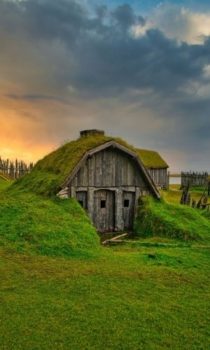New Science Backs Viking Debut in North America Posted by Chelsea B on Oct 29, 2021 in Culture, Living in Sweden, News, People, Science, Travel & Geography, Vocabulary
Just when the Vikings start to fall out of fashion, they do it again. Scientists utilized a new dating technique to reinforce that not only were the Vikings the first Europeans to reach the North American continent, we now have an exact year. In 1021, centuries before Columbus even thought of crossing the Atlantic, the Vikings built a settlement in present-day New Foundland, Canada. This week, we’ll focus on the vocabulary related to the latest scientific discovery with an intermediate-level article and some reading comprehension questions.
First, because Indigenous Peoples’ Day (Former Columbus Day) was just a couple of weeks ago, I feel it’s important to mention the topic of “discovery”. At the time the Vikings landed in North America, the same as 470 years later when Christopher Columbus and his colonizing cronies “discovered America”, there were already millions of people living on the North American continent. The idea of colonization is an important element to consider when studying any language and culture, as it has grave impacts on people and traditions, as well as linguistic implications. Let us remind ourselves as we study the modern-day languages and peoples of the Scandinavian peninsula, it’s important to include indigenous narratives in our work too.
Vikingarna (the Vikings) i L’Anse aux Meadows
It’s not news that the Vikings reached North America before Columbus. In the 1960s, a Norse bosättning (settlement) was discovered in L’Anse aux Meadows in Newfoundland, Canada. Dating techniques of the time, as well as accounts documented in the old Icelandic Sagorna om Vinland (Vinland Sagas), estimated the camp was constructed in about the year 1000 AD. Leif Eriksson is the star of the show here, making it to the North American continent, most believe by happenstance.
But now we know exactly when they lived on the continent. How?! Let’s find out and learn some technical vocabulary, too!
En kraftig solstorm / A powerful solar storm
Forskare (researchers) in the Netherlands used knowledge of a global solstorm (solar storm) in 992 to put the pieces in place for this latest discovery. A new radiocarbon dating technique revealed spår (traces or tracks) of 992’s radiation event within the trees used at the settlement. Radioaktiva kolisotoper (radioactive col isotopes) within årsringarna (the growth rings) of the trees, helped scientists count to the exact year trees were felled to build the camp.
That evidence, plus the markings made by metallblad (metal blades), was consistent with three separate trees found at the site. Pretty neat, eh?
Läsförståelse med vikingarna / Reading comprehension with vikings
I pulled an article from SVT, that comes with a short, 2-minute video from an arkeolog (archeologist) in Uppsala. Read the article, watch the video, and then use the prompts below to write about what you’ve learned!
Läs artikeln från SVT.se här och titta på videon. Sedan svara på frågorna nedan:
- Beskriv vikingarnas expansion i öst och väst!
- Varför är valrossen viktig i denna historia?
- Vad kallas den som arbetar med arkitekt fynd från vikingatiden?
- När upptäcktes vikingarnas bosättning i L’Anse aux Meadows?
- Vilken global händelse påverkade den nya forskningen?
- Hur har forskarna fått en exakt datering till bosättningen?
- Varför är denna metod viktigt för framtidens arkeologi?
- Har du en favorit figur eller gud från vikingatiden?
Now just for fun – what’s your favorite Viking depiction in pop culture? Film, television, music, or movie, tell me below!

Build vocabulary, practice pronunciation, and more with Transparent Language Online. Available anytime, anywhere, on any device.





